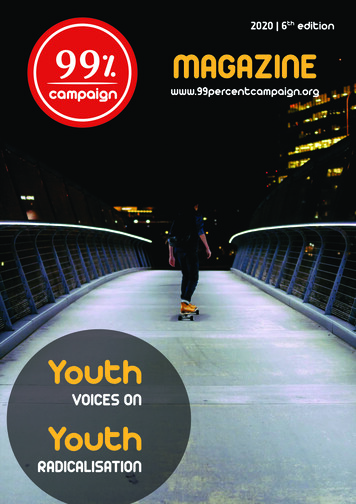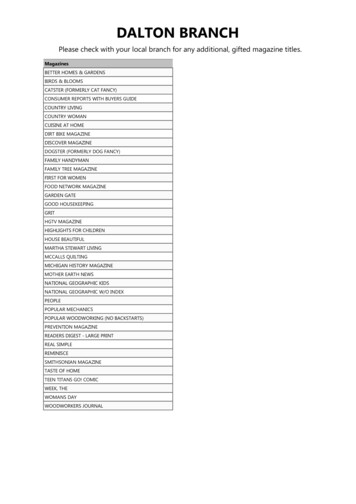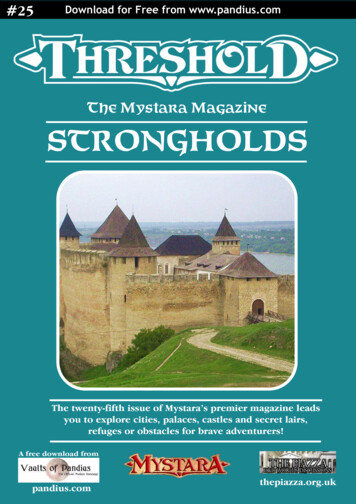
Transcription
2020 6th uthVOICES ONYouthRADICALISATION1
99 campaign magazineIARS Publications14 Dock Offices, London, SE16 2XU, United Kingdomcontact@iars.org.uk www.iars.org.ukIARS Publications an independent publisher specialising in social and political sciences. IARS Publications is a memberof the Committee on Publication Ethics (COPE) and has a non-profit mission. IARS Publications is supported by TheIARS International Institute, which is a leading international NGO with a charitable mission to give everyone a chanceto forge a safer, fairer and more inclusive society.Published in the UK by IARS Publications 2020 IARS PublicationsThe moral rights of the author have been assertedFirst published January 2020Graphic design: Rita Seneca 2020 selection and editorial matter, Theo Gavrielides; individual chapters, the contributorsThe right of Theo Gavrielides to be identified as the author of the editorial material, and of the authors for their individual chapters, has been asserted in accordance with sections 77 and 78 of the Copyright, Designs and Patents Act1988.All rights reserved. No part of this book may be reprinted or reproduced or utilised in any form or by any electronic,mechanical, or other means, now known or hereafter invented, including photocopying and recording, or in any information storage or retrieval system, without permission in writing from IARS Publications. You must not circulatethis book in any other binding or cover and you must impose the same condition on any acquirer.Trademark notice: Product or corporate names may be trademarks or registered trademarks, and are used only foridentification and explanation without intent to infringe.Database right IARS Publications (maker)British Library Cataloguing in Publication DataISBN: to be changed2
YOUR VOICEYOUR MAGAZINEThis publication has been produced within the YEIP / ERASMUS funded projectThe information and opinions expressed in these articles do not necessarily reflect the views of IARS, YEIPor its funders and supporters.The European Commission support for the production of this publication does not constitute an endorsement ofthe contents which reflects the views only of the authors, and the Commission cannot be held responsible for anyuse which may be made of the information contained therein3
THE IARSINTERNATIONAL INSTITUTEThe IARS International Institute was informally set up in2001 by Theo Gavrielides to act as an international networkon youth matters. Since then we have expanded our remit tocover three areas of work: Youth Equalities Justice.IARS is now recognised as one of the words’ leading user-ledInstitutes with a mission “To give everyone a chance to forgea safer, fairer and more inclusive society.”The Institute was formally registered in 2005 and in 2015 wecelebrated our 10 official years of giving. Since our inceptionwe have been providing voice and educational programmesas well as non-profit research, policy and networking servicesof local, national and international significance. We are focused on empowering the most marginalised communitiesthrough direct service delivery, while enabling organisationsto achieve, measure and improve their social impact.We also have a mission to transform young people’s lives byenabling them to have a better future, and participate equally and democratically in civic life. IARS’ young people learnto inform policies and practices affecting them whether at alocal, regional, national or international level. We are dedicated to helping deliver the EU Youth Strategy by “Investingand Empowering” our young people.OUR CONSTITUTIONAL ARRANGEMENTStoring and one-to-one support;By acting as an international network of NGOS bringingtogether people and ideas to share best practice and engagein debates on current social problemsBy carrying out action research and evaluation that is independent, credible, peer-reviewed, user-led, focused andcurrentBy supporting individuals and grass roots organisations tocarry out their own initiatives to shape decision-making andsociety, and by helping them to maximise their social impactBy being an authoritative, independent and evidence-basedvoice on current social policy matters.Led by its founder and Director, Professor Dr. Theo Gavrielides and staffed with a dedicated team of experts, interns andvolunteers, the IARS International Institute is known for itsuser-led robust, independent, evidence-based approach tosolving current social problems. We are acknowledged internationally for our expertise in justice, equality and youth,and have delivered projects in areas such as restorative justice, rehabilitation, human rights and inclusion, citizenship,public services and user-led research/ evaluation.The IARS Articles of Association state that the charity is setup to promote and contribute to the development and civicparticipation of young people, children and adult membersof the community as individuals and members of society by:Providing an infrastructure, training, guidance and support to enable them to undertake research, studies or otheractivities to investigate the issues which affect them and;Encouraging, supporting and facilitating them to acquirea voice in democratic life, and use the useful results of thatresearch and learning to increase awareness and understanding of the issues which affect them including amongst othersdecision makers, governments, policy makers, service providers and the public”.We deliver our charitable mission:By empowering marginalised individuals of our societythrough accredited training, educational programmes, men-4
99% CampaignThe 99% Campaign is a youth-led initiative and digital participation programme aiming to make societymore inclusive, fair and responsive to young people’s views and realities. It achieves its mission by givingdirect voice to the most marginalised young people and by dispelling negative stereotypes.99% Campaign PledgeThe “99% Campaign Pledge” initiative aims to bring together, young people, members of the public,organisations and groups to celebrate the 99% of young people who are making a real and positive contribution to our diverse communities.Those committing to support the 99% campaign and its key principles will be entitled to use the 99%‘pledge mark’ in recognition of their support.By signing up to the Pledge you can display the 99% pledge mark.More -campaign/the-99-campaign-pledge/5
99% MagazineThe 99% Campaign Magazine is a unique youth led magazine collecting thebest articles written about young people on topics impacting on them. Designed, written and published by young people as part of the youth led 99%Campaign.The 99% Campaign Magazine (2nd Edition) is a unique youth led magazine collecting the best articles written about young people on topics impacting on them.Designed, written and published by young people as part of the youth led 99%Campaign, funded by the Nominet Trust.Through a compilation of articles, news, poetry and youth photojournalismprojects, the 99% Campaign Magazine, provides a platform for young people toexpress their stories, views and experiences about issues affecting their daily lives,with the intention of stimulating social action, and influencing key public figuresin the media and governments. This entirely youth-led and youth focused workrepresents their real voices and their aspirations to create a fairer future for themselves and their peers from diverse backgrounds.The fourth issue of the 99% campaign magazine, the lasting impact of Brexiton young people is explored. This publication allows young people to expresstheir concerns related to employment, social care, the economy and education.6
FOREWORDTHE YOUTH EMPOWERMENT ANDINNOVATION PROJECT (YEIP)PROF. THEO GAVRIELIDESIARS Founder andYEIP Scientific CoordinatorWelcome to the 5th Edition of the 99% Campaign Magazine.This year, the Magazine is dedicated to the issue of violent youth radicalisation. Over the last few years,the terms violent radicalisation, hate crimes, xenophobia, extremism and terrorism have become centralfeatures in our political, policy and public debates, social media, academic writings and research, TV,radio, paper and online news. Indeed, much has been written and said about these terms; the beliefs andperceptions that feed them, as well as the criticism, sensitivity and controversies that surround them. It isnot my intention to repeat them here.In fact, the purpose of this magazine is to help move the debate forward by helping all those interested inthe topic of violent youth radicalisation to see it from a new prism. It is with this hope that I applied tothe European Commission (EC) to fund the Youth Empowerment and Innovation Project (YEIP) thathas informed this publication.YEIP was a 3-year Erasmus funded programme that designed a youth-led, positive policy preventionframework for tackling and preventing the marginalisation and violent radicalisation among young people in Europe. The project run between March 2017 – February 2020. It was developed in response toErasmus Key Action 3 – Policy Experimentation. The Erasmus Call was directed to high level publicauthorities, focusing on policy. IARS agreed with the Home Office to delegate its power to the Institute,which applied on its behalf and was successful in proposing a youth-led project that would bring togetherone of the largest consortia of public and civil society organisations to achieve the Call’s objectives.Led by young people and YEIP was delivered in partnership with 18 partners from seven EU countries toconstruct and test an innovative, policy intervention model founded on the principles of restorative justice, positive psychology and the Good Lives Model (GLM).YEIP was implemented through the construction and field validation of tools (YEIP PREVENT model/interventions, toolkit, training) in 4 environments (schools, universities, prisons, online) in the UK,Greece, Cyprus, Portugal, Sweden, Italy and Romania.The project was broken down into four scientific blocks. The first block involved secondary research aswell as primary fieldwork with 133 participants. The second block carried out fieldwork with 380 participants. The third scientific block involved a total of 478 young people, 354 professionals and 195 policy7
99 campaign magazinemakers. Finally, the fourth block involved 1408 youngparticipants and 517 professionals.that they have indeed identified themselves, and takeresponsibility for developing and implementing a solution. Consequently, the youth-led method repositionsIn total, YEIP directly engaged with and spoke to 3540 young people as important stakeholders who can makeindividuals from as young as 16 years old to 78. Argu- unique decisions which impact on the quality of theirably, this is one of the largest scientific studies on violent lives, rather than simply accepting the position as passiyouth radicalisation in Europe.ve subjects whose lives are guided by decisions made byadult ‘others’.It is my hope that YEIP and this magazine will lay thefoundations for systemic change in the way we deal with To this end, we took the following steps, when conviolent youth radicalisation at the national and EU lev- ducting youth-led research for YEIP:els. The ultimate objective was for the project to helpimplement the EU Youth Strategy’s objective of pre- Step 1: Relinquish power and “remove hats”venting the factors that can lead to young people’s socialexclusion and radicalisation. The project was also in line Step 2: Reach out widely and recruit diverse groups inwith the EU’s Counter-Terrorism Strategy of 2005 (re- partnership with othersvised in 2008 and 2014). I hope that this book and theStep 3: Empower through ad hoc and tailored accreresults of the project help deliver these strategies.dited training that is flexible and adjustable to youngFinally, I want to believe that the success of this youth- people’s needs as these are defined by their diverse livesled project will demonstrate to European citizens theStep 4: Facilitate discussions on current topics that needleadership and determination of EC institutions in roochangeting out the reasons that lead to young peoples’ marginalisation and violent radicalisation, firming up in this Step 5: Coordinate their action research and support toway trust and confidence. At a time, when European write evidence based solutions through peer reviewedsolidarity is questioned, our young people can lead us in processesre-establishing the very values and reasons that unitedStep 6: Support the evaluation, monitoring, projectEurope in the first place.management and control of all previous steps throughyouth-led tools and a standing Youth Advisory BoardYEIP’s youth-led research methodologyStep 7: Reward and accredit.One of the most innovative features of YEIP was itsground-breaking and unique youth-led research andproject methodology. This drew from the field of participatory action research, which is experimental research that focuses on the effects of the researcher’s directactions of practice within a participatory communitywith the goal of improving the performance qualityof the community or an area of concern (Dick 2002).Within this realm, youth-led research is identified. Admittedly, the extant literature on youth-led research isscant and thus the risks considerable (Gavrielides, 2014;Gough, 2006). However, IARS has been a pioneer inthis area having introduced some of the first youth ledfieldwork in Europe and tested them for policy reform(see Youth in Action)1.The NGO partners in each participating country, recruited and trained a total of 75 young people in orderto empower them to carry out the research themselves.As a youth-led project, YEIP did not want to replicatethe methods that have been used to understand violentyouth radicalisation. Below you can see a breakdownof the demographics of the young people who led onthe research and who continue to support the projectthrough other activities.The impact and scalability of the YEIP GLM-based policy measure was assessed through a semi-experimentalmethodology that sought to identify and evaluate thecausality link between our measure and the change itIn a paper published in the Youth Voice Journal, a young aims to make for young people at risk of radicalisationresearcher, Cass, describes the underlying principles of and marginalisation. A combination of qualitative andyouth-led research and policy as “(1) addressing power quantitate research tools were used.imbalances; (2) valuing lived experiences; (3) respectingThe scientific work of YEIP comprised of five differentchoice in participation; and (4) empowerment”. Thebuilding blocks that were represented via different workyouth-led approach dictates that young people must bepackages (WPs) WPs. Following a thorough literatureleft to instigate potential solutions to a problem, onereview (WP1) and the collection of stakeholders’ views18See www.youthvoicejournal.com
through youth-led research (WP2), we constructed the tools that implemented our policy measure (i.e. the YEIPPrevent model/ intervention and a toolkit). These tools were used to capacity build professionals working in ourselected environments. Subsequently, field trials (WP3) were conducted in the participating countries. These piloted and evaluated the tools implementing our policy measure and were observed through a mixture of qualitativemethodologies. Impact measurement was achieved through a before-after comparison. To triangulate the findings,a pan-European quantitative survey was also carried out (WP4). The research design and approach were youth-led,following the principles of participatory, youth-led action research. Below is what we originally envisaged:First building block (WP1): It aims to “build the foundations” by analysing the current state of the art. To thisend, existing knowledge in the selected case study countries will be assessed both in terms of policy, research andpractice. A comparative analysis between the case studies and a cross European review will also be conductedalongside a stakeholder mapping. Following this, our experimentation protocol will be finalisedSecond building block (WP2): This will have two aims. First, to test the underlying hypothesis of the GLMbased YEIP policy measure. Second, to construct the tools that will implement YEIP’s policy measure (i.e. theYEIP PREVENT model/ intervention and toolkit). Both goals will be achieved by carrying out youth-led primaryresearch in four environments: schools, universities, Youth Offending Institutions and online.Third building block (WP3): This will have two aims. First, to test the YEIP GLM-based policy interventionby conducting field trials following capacity building of professionals using the tools constructed under buildingblocks 1 and 2. They will be conducted in the country case studies within the four selected environments. Second,to identify and evaluate a causality link between YEIP’s policy measure and tools, and the change that has occurredin our target groups within selected environments. The findings will determine the logic behind the change(counterfactual analysis). A quasi-experimental method will be used by relying on assumptions that will help usjustify the claim that the comparison group is similar to the treatment group. To this end, we will carry out beforeafter comparisons using the same population which undertook the YEIP intervention within a 6-month period.Fourth Building block (WP4): This will aim to triangulate our findings through a quantitative methodology thatwill counteract the weaknesses found in qualitative methods. Two online surveys will be designed and disseminatedacross Europe throughout the lifetime of WP2 and 3.Figure 1: The YEIP Building BlocksBackground & ImpetusYEIP was created in response to a current social need to have more effective youth policies that can enhance youngpeople’s social inclusion and minimize the risk of radicalization with greater ‘buy in’ from youth themselves.To this end, YEIP constructed and tested an innovative policy intervention, which generated a set of actions that9
moting the talents and strengths of vulnerable youngpeople and through this approach help develop positive identities. The extant literature has defined these asbeing “the internal organisation of a coherent sense ofself ” (Dean 2014). The GLM operates in both a holistic and constructive manner in considering how youngpeople t risk might identify and work towards a way ofliving that is likely to involve the goods we seek in life,Through the use of multi-disciplinary tools, we con- as well as a positive way of living that does not involvestructed tools that tested and implemented this measure or need crime (Scottish Prison Service 2011).at the local, national and EU wide level. The ultimateobjective is for the project to help address the Erasmus In this process, the argument is that the model worksKA3 objectives (especially PT7) as these are aligned towards a positive, growth-oriented change in life wherewith the EU Youth Strategy’s objective of preventing the an offender works on the development of the values,factors that can lead to young people’s social exclusion skills and resources towards life based on human goods that is a necessary counter-balance of managing riskand radicalisation.alone (Ward, Mann and Gannon 2007: 92), i.e. risk isExisting approaches are constructed within the Risk managed as well as seeking to develop positive life alNeed Responsivity (RNR) model for prevention. De- ternatives. This approach is aligned with the underlyingveloped in the 1980s by Andrews, Bonta and Hope philosophy of 2014 EC report on youth workers, which(1990), RNR’s focus is on reducing and managing risk asks for a more coordinated effort in supporting youngas well as on studying the process of relapse. Patholo- people with fewer opportunities by tapping into theirgy-focused research and intervention have consequently talents and not by further marginalising them.been developed as tools for RNR based approaches toThis magazine draws some important conclusions thatrehabilitation.make me ask: what will it take for society to finallyAccording to Maruna (2006) and Gavrielides and Piers raise the mirror of responsibility and look well into(2013; 2015), RNR is now challenged at practical, po- its reflection? Every time I look into this mirror, I seelicy and financial levels. They argued that concentrating nothing but myself and a thousand other fellow cition criminogenic needs to reduce risk factors are not a zens. We are the real architects of the social fabric thatsufficient condition when it comes to young people. generates the extremist ideologies, which then graduallyMcAdams (1994; 2006) argues that integration and re- corrupt universal values such as tolerance and the relatedness for young people are crucial in encouraging spect of life, dignity and brotherhood. The extremistdesistance from violence and radicalisation. Politicians ideology that leads those young men, men and women,and the public also seem to agree with the extant lite- to act inhumane is not an alien virus of unknown orirature. For instance, the UK Justice Secretary said that gin. It is a product of our way of living.prison often turns out to be “a costly and ineffectualapproach that fails to turn criminals into law-abidingcitizens” (Travis 2010).YEIP aimed to turn the RNRapproach on its head. Instead of “managing” youngpeople as “risks”, our policy measure focused on prowill help address this need at the local, national and European levels. This measure is founded upon restorativejustice and the Good Lives Model (GLM), which assumes that we are goal-influenced and all seek certain‘goods’ in our lives, not ‘material’, but qualitative, alllikely to increase or improve our psychological wellbeing (Ward, Mann and Gannon 2007).10
EDITORIALDAVID RUAHMember of the RadicalisationAwareness NetworkExtremist violence is on the rise in Europe, and this is no longer a mere local problem confined to the different nation-states, although it is neither an exclusive sign of the 21st century. The ideological extremistnature that leads to terrorist violence is rooted in our ancient psychology, such as our animal desire forsocial and political power. In this sense, we will always have problems connected to radicalisation fromtime to time, and we will always have to minimize them, but radicalisation as a social phenomenon isdependent on contextual variables that shape it, causing extremist movements to adopt new strategies.What, then, are the contemporary strategies and trends of the new extremist movements?If, on the one hand, we have Islamist-related radicalisation and far right-related radicalisation, both sharemutual characteristics that attract a growing number of followers for each one in a reciprocal power cycle.First, both consist of a nonlinear social process that is associated with psychological or social vulnerability as a trigger of the process. Such vulnerabilities may be characterized as a sense of existential demandcoupled with a political scepticism that considers elites corrupt and ineffective, but there may also beother factors such as financial needs and unemployment, or even discrimination, and xenophobia. Thesevulnerabilities underline the radicalisation process and, if not properly addressed, can progress, especiallyin cases where the vulnerable individual contacts other already radicalized vulnerable individuals. Thenext phase then consists of creating social networks that exploit feelings of social injustice in a solid extremist ideology, such a stage does not necessarily predict violence but may materialize minor offences inthe context of organized militancy. The online world plays an important role in accelerating the processof networking because it allows extremist groups to become online militias that disseminate illegal hatespeech.After the militancy phase, the vulnerable individual then becomes an extremist, but in a robustcognitive view, through which the individual comes to claim a set of immutable beliefs that underminefreedom of belief, such as hatred of a minority, not tolerating other perspectives and denying the possibility of debate.Finally, the last stage of this radicalisation process when, eventually, the individual becomes a terroristin which he or she commits acts of violence against civilians in order to achieve political goals. This laststage is not necessary in order for someone be considered a radical, but it is for a radical to be considereda terrorist.On the other hand, when we are referring to radicalisation, we are referring to new contemporary strategies, such as (1) the operational decentralization of terrorist cells, (2) the existence of self-processes ofradicalisation, (3) the problem of hate language ambiguity and (4) the online world as a catalyst for radicalisation. All the mentioned features are shared by both extremist violence movements associated withIslamist views and the far right, as well as others. The characteristics of operational decentralization and11
the existence of radicalisation self-processes lead us tocharacterize the contemporary threat of radicalisation astransnational in concept, but also in its own operationalization. Therefore, if Europe wants to combat and prevent radicalisation effectively, it must take into accountits transnational threat, which in turn implies the existence of radical processes in several European countriesbut also their contextualization to national realities: certainly, problems with Islamic radicalisation in Francewill not be answered in the same way as problems withviolent neo-Nazi groups in Germany.The Youth Empowerment and Innovation Project(YEIP) aims to respond to this fragmentary identity ofradicalisation in Europe through the plural formationof its own consortium comprising 18 partners locatedin 7 European countries, namely the United Kingdomas consortium’s leader, Greece, Cyprus, Italy, Portugal,Sweden, and Romania. A study of radicalisation in somany countries has a sufficiently representative sampleof what European radicalisation is as a concept which isa social representation of the sum of its constituent parts. This study intends to build and test a model of political intervention based on the principles of restorativejustice, positive psychology and the Good Lives Model,structured on the basis of 5 scientific work-packagesand based on the youth-led methodology that leads theproject in all its parts. One of the cross- sectional conclusions inferred by the reader when reading the project’sbooks is that Europe does not have an international legal definition of radicalisation, but various working national definitions of radicalisation empirically inferredthroughout the project. Another conclusion that we caninfer is that in some countries, participants referred tospecific forms of radicalisation connected to criminalphenomena, what can be relatable to the so-called nexusbetween terrorism and crime. For instance, accordingto the project’s participants, in countries such as Italy,radicalisation is related to Mafia. On the other hand, inPortugal, there are no signals of radicalization but thereare other relatable criminal problems such as cyberbullying and online hate speech. In the same country, thereare a lot of initiatives to counter marginalization leadingto organized crime, even though there are no initiativesdirectly related to radicalisation leading to terrorism.involves them in the civic and political participation ofsociety, how can they distinguish the right ideals frommere demagogic and extremist manipulation? We needto actively involve young people in research, policy andpractice related to the prevention of radicalisation leading to terrorism (PVE).The Security Council Resolution 2250 on Youth, Peace, and Security recognizes the importance of engagingyoung women and men in modelling and sustaining security and peace initiatives. UNSCR 2250 calls on theMember-States to include young people in their institutions and mechanisms to prevent violent conflict, including the prevention of radicalisation processes. YEIPfollows Resolution 2250 stated by the United Nationswhen creating a transnational project that is not onlypeer-participatory but youth-led, particularly when involving youth in developing policy- oriented research.And this is a characteristic that makes the project unique, as many projects affirm youth participation, butfew materialize it in more than merely symbolic functions.Nevertheless, we should still address the question: whyshould projects, such as the YEIP, decide to involveyoung people in the world of the prevention of violentextremism? In the first place, because young people havepeer-to-peer access to networks that include vulnerableyoung people, but also because most of the time already have developed counter and alternative narratives, aswell as resilience to violent extremism and other formsof violent conflict. Counter and alternative narrativesare highly important to challenge online hate speechand online propaganda, and youngsters are innovative, creative and used to work with social media. Finally, they understand the way young people look at theworld and what will grab their attention. For all thesereasons, yes, we should actively involve young peoplein the world of PVE, and YEIP truly is an innovativeproject in doing that.Furthermore, the YEIP project cycle insightfully infersthat radicalisation is related to social and psychologicalmanipulation and that the hearts of young people arethe most vulnerable in this regard. Because young people are the main target and victims of radicalisation,they are characterized by still believing and claimingideals and fighting for them. However, if nobody12
13 p
The 99% Campaign Magazine (2nd Edition) is a unique youth led magazine col-lecting the best articles written about young people on topics impacting on them. Designed, written and published by young people as part of the youth led 99% Campaign, funded by the Nominet Trust. Through a compilation of articles, news, poetry and youth photojournalism








![Tamil Computer Magazine Free [WORK] Pdf](/img/63/tamil-computer-magazine-free-download-pdf.jpg)

